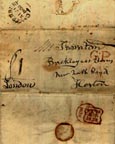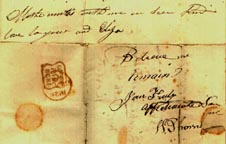Eunice and Ron Shanahan have shared with readers of the Victorian Web this material from their website, Letters from the Past. Click on thumbnails for larger images.
This letter from the past — unlike the letter from John Brook, Somerset Herald a member of the Sovereign's household — is from a member of the 'general public'. The writing inside, and the first word "Mr." of the address panel is with a very fine nib in a pale ink. However, the address has then been completed in a very thick black ink "Thornton Bricklayers Arms New North Road, Hoxton LONDON".
Postal Markings

- The letter was posted in Canterbury and received the standard Provincial dated town name stamp without a mileage number in use from about 1827.
- The manuscript '8'. Canterbury is in Kent 56 miles from London and the rate from 1812-1839 for that distance was 8d
- Circular red datestamp of the General post applied at the GPO London. It is a morning duty stamp, (shown by the year being in a straight line, not an arc) the day on both sides of month (25 AU 25) and with the code letter G. This type of stamp was in use from 1810 to 1840. The code letters were from A to G (with H coming in use later ). This letter identified the cancelling table where it would have been stamped and sorted for delivery
- G:P. in Red General Post in use from 1837-1839. This stamp was applied to letters transferred from the General Post to the Twopenny Post for delivery by one of their letter carriers and on which delivery charge was to be collected. From 1837 when day mails were introduced, mail which arrived in London later than the first morning arrival at the General Post Office, were all delivered by the Twopenny Post letter carriers. At that time they had deliveries at 2pm, 4pm, 6pm and 8pm. This type with a semicolon between the letters and a full stop at the base of the letter P was in use 1837-1839.
- a red, indented oval stamp showing the date/time the letter was processed for transfer to the Twopenny Post in London for delivery. This 3-line stamp, time (10 Fn 10)at the top, the day, (Aug 25) in the middle, the year (1838) at the bottom, was in use at the Chief Office from 1836 with various modifications. This type with no full stops between the details, was in use from 1838 - 1843 and can be identified as a Chief Office stamp as it has the month before the day
- there is also what appears to be a handstamp '1', but as it should have been a 2d charge in 1838 - I am inclined to think that this was an attempt by the writer to check if the pen was any good before writing the address!
I found out from Stuart Adams, a fellow member of the local history e-mail list on the Internet, that there are a surprising number of entries for Mr. Thornton, during the years 1837 until 1848. One London Trade directory (Robsons) shows an entry for 1837; publican Alexander Thornton the Bricklayers Arms, New North Road, Hoxton. In the 1839 Pigot's directory the entry is for Alexander Thornton at the Bricklayers Arms, 4 Stephen's Place, New North Road.
The London Post Office directories of the time show no entry for Alexander Thornton in 1836, the first entry being for 1839, the year after this letter was written. Between 1843 and 1848 The Post Office directories list him but the address has changed from Stephen's Place to 8 Upper Dorchester Place, Hoxton. However in the next available directory of 1855, he does not get a mention.
The Letter
Now to the letter, which I have quoted as it was written because of the spelling and phrases the son used to his father. Because of the two different hands, it looks as though someone has written the letter for him, but he has signed and addressed it himself. It is undated.
Canterbury
Dear Father
We receiv'd the letter Pr Mr Dudly and were most happy to hear that you are quite well and going on comfortably at home. We received the Salmon and a most beautiful one it was, we all very much enjoyed it. My Mother has been very poorly since Sunday and was oblig'd to have Mrs Hatch Medical attendant - but she his a considerably deal better now, I have bean to the races two days and my mother went on Thursday the grand day.
I am a wonderful deal better myself.
Note: if the salmon had been caught in the river Thames and been sent from London by carrier, no wonder his mother had been very poorly. She must have recovered enough to go to the races. The Canterbury Races have a long history, in fact Daniel Defoe, the author of Robinson Crusoe, mentioned them in the report of his journey around Britain in 1722.
Please God if nothing happens more than present my Mother intends returning with Mr & Mrs Dudly on Monday next as Mrs Hatch does not intend coming to town until I return. And if you will send Bob over to Mr Dudley and tell them not to send to the Steam Wharf untill Monday. As the men were to be there on Saturday you will send him over as soon as you can conveniently after he comes back from Mr Love at 2 oclock.
Note: The Pigot's trade directory has an entry for Dudley (John) in 1839 as a chairmaker at 4 Prospect Place, Kingsland. which is just north of Hoxton above the Regents Canal, where the furniture business was fairly wide spread at that time. Could Mr. Dudley have been making furniture for the Bricklayers Arms? That seems a reasonable assumption.

We recevd the basket with the Liquor quite safe. Mr & Mrs Hatch are exceedingly kind to us. They send their best respects to you as well as Mr & Mrs D.
Mother unites with me in her kind love to you and Eliza
Believe me,
I remain your [change of handwriting]
truly affectionate son
H Thornton"
I have not been able to confirm the whereabouts of the Steam Wharf, but the Regents Canal was a very busy waterway which carried a great deal of trade, as the canals were a much better system of transportation than the roads at this time. The map shows that the New North Road crosses the Regents Canal over the Sturts Bridge, near Sturts Lock, and just a bit further on is the Islington Tunnel which was opened in 1820. The tunnel is 960 yards long, and as it had no towpath, the bargees originally had to propel the barges through by lying on their backs on the barge and pushing against the wall of the tunnel with their feet. This was known as 'legging'. In 1826 a steam tug was introduced which pulled itself along a chain on the canal bed. So I wonder if there may have been a wharf associated with the Islington Tunnel - which could have been known as the Steam wharf by the local trades people.
I find it interesting to see old letters like this, showing that parcels and goods were transported with confidence. I would have thought a basket of liquor would have been extremely vulnerable to breakage and/or theft, but their confidence in the carrier was obviously justified.
Last modified 30 May 2010